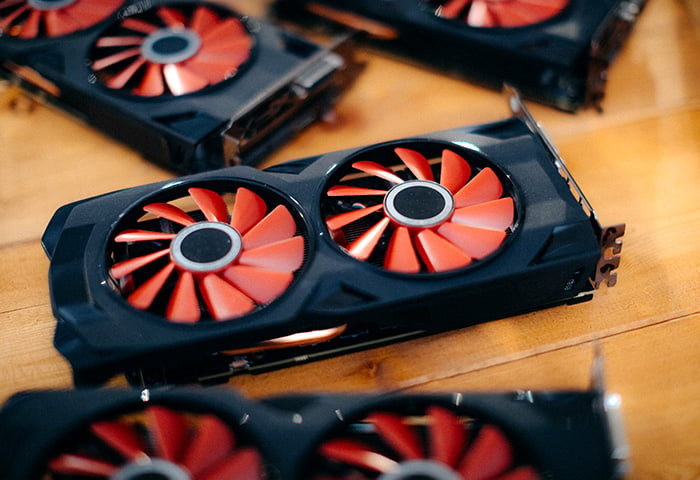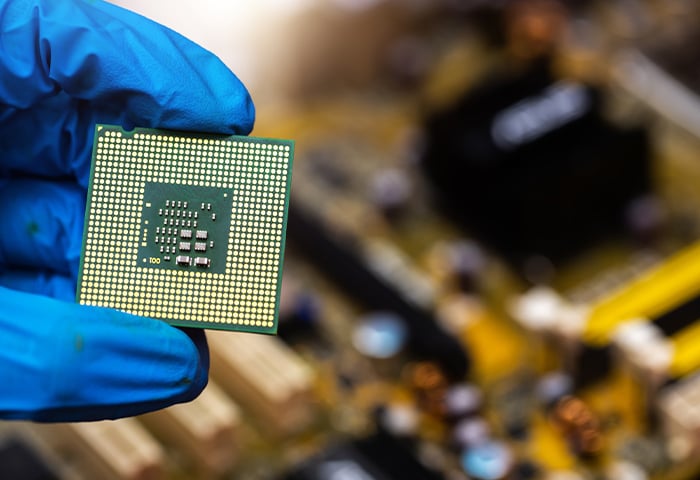(Not sure about overlocking just yet? See our full overlocking explanation, safety concerns, and how to find out if your computer supports overclocking before you jump in.)
Automatic vs. manual overclocking
Time to get started: decide whether you’ll handle the process automatically with an overclocking tool, or manually on your own. Some motherboards include an auto overclock option, so you can proceed without any additional software. If that applies to you, consult your motherboard’s manual for instructions on how to utilize this option.
In July of 2019, Intel released an auto overclock tool for a select range of their most powerful gaming processors. You can choose either a first-party solution by your CPU’s manufacturer or one of the various third-party tools available, but be sure to research your options thoroughly before installing something that can potentially burn out your computer.
While automatic overclocking is simpler, it doesn’t offer the same degrees of nuance and control as the manual route. Manual overclocking allows you to precisely adjust your CPU’s settings as incrementally as you’d like, so that you can minimize the risk of overheating.
Whether you go for auto or manual overclocking, the first few steps of the process are the same — so let’s get overclocking.
How to overclock your CPU
Ready to get started? We’re here to support you with every part of the process. Follow along with our step-by-step guide to find out how to overclock your CPU safely.
1. Check your CPU's core temperature
Since overclocking will raise your CPU’s core temperature, you’ll want to measure it first so that you can establish a baseline for future tests. Check your processor’s temperature now so you can compare any changes you experience while overclocking.
2. Monitor the stability of your CPU with a stress test
Your next step is to ensure that your CPU is stable enough to handle an overclock. If not, you risk burning it out and causing irreparable damage to your computer. You’ll do this by performing a CPU stress test, where you push it to its limits and see how it handles the workload.
Download a stress-testing program like Prime95 or IBT and let it run. During the test, it’ll place a sustained 100% workload on all your CPU cores. Make sure your computer is clean and properly ventilated before undertaking a stress test, as it will heat up during the test. If you haven’t cleaned your computer fans in a while, now would be a great time to start. Check your CPU temperatures while you test!
3. Evaluate your CPU’s current performance
Establish a benchmark for your CPU so that you can evaluate the results of your overclock. A tool like Cinebench will put your CPU to work, then score its performance. It does this by simulating a video render. You can also try 3DMark, which tests your CPU from a gaming perspective. Note your computer’s performance score — we’ll be coming back to that later.
Monitor your CPU’s temperature during the test and observe the highest temperatures recorded. This can help provide an idea of just how much tolerance your computer will have for overclocking.
4. Access your computer’s UEFI or BIOS
You’ll need to access your computer’s UEFI (or the BIOS on older chips) and find the Overclocking tab. If you’re using Windows 10 — as you should be, since older software is more prone to hacking — you can access this section via your Settings menu. Follow these steps:
-
Open the Settings from your Start menu or by using keyboard shortcut Windows + I, then click Update & Security.

-
Select Recovery.

-
Click Restart now under the Advanced startup heading.

-
Your computer will restart, then display a menu with various startup options. Choose Troubleshoot.

-
In the next menu, select Advanced options and then UEFI Firmware Settings, then hit Restart. Once your computer reboots, it’ll display your UEFI, where you’ll be able to adjust your clock multiplier.


5. Choose your multiplier (manual overclocking only)
Find the Overclocking section in your UEFI or BIOS. Depending on your CPU’s manufacturer, it may be called “OC” as well.
Find your clock multiplier and raise it by one increment. If you go too fast, you might damage your computer. Raise the multiplier just a hair, then save your settings and reboot. Stress-test and benchmark your CPU again and monitor its temperature. You can increase the multiplier for one core, then go back and raise the others. The more cores you overclock, the hotter your system will run. You can only raise your multiplier so high before your CPU will exceed its power supply. Give it the juice it needs by finding the voltage setting and raising that slightly as well. Again, treat this as a gradual and incremental process. With a bit more voltage to draw from, your CPU will be able to handle additional increases to its multiplier. Reboot, stress-test and benchmark, and watch that temperature.
You can only raise your multiplier so high before your CPU will exceed its power supply. Give it the juice it needs by finding the voltage setting and raising that slightly as well. Again, treat this as a gradual and incremental process. With a bit more voltage to draw from, your CPU will be able to handle additional increases to its multiplier. Reboot, stress-test and benchmark, and watch that temperature.
Did you get a bluescreen?
If your computer bluescreens upon rebooting, don’t worry. This just means that you’ve pushed your overclock too far. Go into your UEFI or BIOS and revert to your previous settings. If you like, you can reset your settings to their original values and start again.
Chosen automatic overclocking instead?
Automatic overclocking chooses the multiplier on your behalf, and so you won’t need to do it yourself. You can ignore the preceding step and move on to the last phase.
6. Test, test, test
Testing your overclock is the most important stage of the entire process. Each time you increase your multiplier or your voltage, save your settings, reboot, and test. Run your stress-testing tool, then run your benchmarking tool. Monitor your CPU temperature throughout the process.
After your benchmarking tool has completed its assessment, compare the new score to your original one. Did it increase? If so, your overclock was successful!
What does overclocking mean?
So what is overclocking a CPU? Overclocking is a process that forces your computer’s CPU to operate at a speed greater than its recommended maximum. It’s a method for squeezing more power from your CPU without making any physical modifications to your computer.
When you overclock, you override a chip’s default settings and set it to run at a speed higher than the official limit set by its manufacturer. This may sound risky, but it’s very much possible to overclock your CPU safely and without any lasting negative effects.
What does overclocking do?
Overclocking works by raising the clock rate of your CPU. Clock rate is a measure of a processor’s speed. The higher this number goes, the greater the workload the processor can handle. Clock rate is measured in gigahertz (GHz).
When you overclock your CPU and raise its clock rate, you’re boosting its performance by enabling it to handle tasks at a greater frequency than before. This same reasoning also applies to your graphics processing unit, or GPU. Overclocking your GPU is a great way to enhance your gaming experience.
Is overclocking safe?
Overclocking is safe if performed carefully and correctly. You need to ease your CPU into higher frequencies by gradually raising its clock rate, then checking each time to ensure everything is functioning normally. Go slowly: patience is the key to a safe and successful overclock.
The danger of CPU overclocking comes from the additional heat it creates. When you exercise — when your body operates at a higher workload than normal — you feel hot and may start sweating. The same goes for your CPU. Higher frequencies result in more heat. Any attempt at overclocking needs to account for this excess heat so as to prevent damage to the computer’s delicate components. Overclocking will also likely void the manufacturer’s warranty for your chip, so if that’s something that matters to you, proceed with caution.
You can mitigate some of the adverse consequences of overclocking with a monitoring program like AVG TuneUp. It’ll keep your device performing optimally at all times to minimize inefficiency and reduce the need for overclocking.
Why should you overclock your CPU?
Overclocking your CPU makes it more powerful. But before going ahead, there are two questions you’ll want to ask yourself. The first is this: Should I overclock my CPU? You might not need the extra power. In many cases, your computer’s stock settings will be more than sufficient to deliver satisfactory performance in everyday situations. You might want to try cleaning up your computer to get some extra speed before you go down the overclocking route.
Modern video games place heavy demands on your system in order to look and perform their best. Serious gamers looking to create the best possible gaming experience can consider overclocking as one method for attaining it.
Outside of gaming, the additional speed gained via overclocking can be helpful to anyone performing resource-intensive tasks such as visual design or video rendering. It’s one of the many ways these professionals can speed up their PCs for maximum results.
If your answer to the first question is “yes,” you’ll need to ask yourself the second: Can I overclock my CPU? Not all processors can be overclocked. Those that can feature what’s referred to as an “unlocked multiplier,” which means that you can customize their clock rate.
Research the processor in your machine to determine whether or not overclocking is a viable option for you. For example, any Intel processor in the X series can be overclocked, as can any with a model number ending in K. All current AMD Ryzen CPUs support overclocking.
Commonly asked questions
Still unsure about overclocking your CPU? Continue as we explore several of the most common overclocking concerns.
Can overclocking damage your CPU?
You’re probably not going to fry or burn out your CPU by overclocking. Rather, your computer will bluescreen or reboot. You’ll need to go back into your UEFI/BIOS and reduce your overclock or restore your default settings. That’s why you need to proceed carefully and test with every adjustment you make.
What happens if I overclock my CPU too much?
Overclocking creates heat, and excess heat stresses your computer’s system. You can permanently damage your CPU if your computer isn’t properly cooled, or if your overclock is too severe — though this is unlikely. The most common impact of excess overclocking is an unstable system.
A functioning overclock doesn’t necessarily translate to a safe one. Even if your overclocked computer starts up and runs normally, it doesn’t mean that it’s healthy.
Are the effects of CPU overclocking permanent?
Overlocking effects are relative to the demands you place on your computer. As technology improves and newer machines become more powerful, older computers necessarily struggle to keep up. The same performance you enjoyed after an overclock may fade if you’re still using the same computer five years later to run contemporary software.
If you have a good cooling system in your computer, your overclocking benefits will last longer. And because overclocking places additional stress on your CPU, better cooling will reduce the long-term wear and tear.
Can I overclock the CPU on any device?
Overclocking isn’t possible on any device, and even if it were, that doesn’t mean it would always be a good idea. The strongest candidates for overclocking are devices with powerful cooling systems, such as a custom-built gaming computer. If you’re using a stock machine, exercise caution when delving into how to overclock a PC.
While you technically can overclock a laptop CPU or your mobile device, these usually have much stricter limitations on what you can achieve — especially phones and tablets.
Reduce the need for overclocking with AVG TuneUp
Overclocking isn’t the only solution to a lagging PC, and while it’s beneficial, it’s not without its risks. You can improve your computer’s performance by keeping it optimized and free of junk files that clog it up and waste space. AVG TuneUp extends the lifespan of your machine and speeds it up with a suite of innovative, performance-boosting features.







 You can only raise your multiplier so high before your CPU will exceed its power supply. Give it the juice it needs by finding the voltage setting and raising that slightly as well. Again, treat this as a gradual and incremental process. With a bit more voltage to draw from, your CPU will be able to handle additional increases to its multiplier. Reboot, stress-test and benchmark, and watch that temperature.
You can only raise your multiplier so high before your CPU will exceed its power supply. Give it the juice it needs by finding the voltage setting and raising that slightly as well. Again, treat this as a gradual and incremental process. With a bit more voltage to draw from, your CPU will be able to handle additional increases to its multiplier. Reboot, stress-test and benchmark, and watch that temperature.









